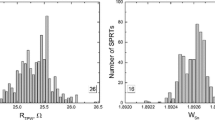Abstract
Interpolation error is a major source of uncertainty in the calibration of standard platinum resistance thermometer (SPRT) in the subranges of the International Temperature Scale of 1990 (ITS-90). This interpolation error arises because the interpolation equations prescribed by the ITS-90 cannot perfectly accommodate all the SPRTs natural variations in the resistance–temperature behavior, and generates different forms of non-uniqueness. This paper investigates the type 3 non-uniqueness for fourteen SPRTs of five different manufacturers calibrated over the water–zinc subrange and demonstrates the use of the method of divided differences for calculating the interpolation error. The calculated maximum standard deviation of 0.25 mK (near \(100\,^{\circ }\hbox {C}\)) is similar to that observed in previous studies.


Similar content being viewed by others
References
CIPM, The International Temperature Scale of 1990 (ITS-90) (1989)
R. White et al., Uncertainties in the realisation of the SPRT sub-ranges of ITS-90. Working Document of the CIPM Consultative Committee on Thermometry CCT/08-19 (2008)
L. Crovini et al., The platinum resistance thermometer range of the International Temperature Scale of 1990. Metrologia 28, 317–325 (1991)
J. Ancsin, E.G. Murdock, An intercomparison of platinum resistance thermometers between \(0 ^{\circ }\text{ C }\) and \(630 ^{\circ }\text{ C }\). Metrologia 27, 201–209 (1990)
G.F. Strouse, NIST assessment of ITS-90 non-uniqueness for 25.5 \(\Omega \) SPRTs at gallium, indium and cadmium fixed points, in Temperature: Its Measurement and Control in Science and Industry, vol. 6, ed. by J.F. Schooley (AIP, New York, 1992), pp. 175–178
R. White, P. Saunders, The propagation of uncertainty with calibration equations. Meas. Sci. Technol. 18, 2157–2169 (2007)
N.S. Bakhvalov, Numerical Methods, 1st edn. (Mir Publishers, Moscow, 1977), pp. 38–50
R. White, G. Strouse, Observations on sub-range inconsistency in the SPRT interpolations of ITS-90. Metrologia 46, 101–108 (2009)
BIPM, Evaluation of measurement data—Guide to the expression of uncertainty in measurement JCGM 100:2008 (2008), http://www.bipm.org/utils/common/documents/jcgm/JCGM_100_2008_E.pdf
Acknowledgements
This work was performed in the frame of EMRP (European Metrology Research Programme) project “NOTED - Novel Techniques for Traceable Temperature Dissemination - WP2.” IPQ and VSL were partners in this work package. We are grateful to Dolores del Campo for making available CEM calibration data.
Author information
Authors and Affiliations
Corresponding author
Additional information
Selected Papers of the 13th International Symposium on Temperature, Humidity, Moisture and Thermal Measurements in Industry and Science.
Appendices
Appendices
1.1 Proof of Interpolation Error Theorem
Considering \(p_n \left( x \right) \) a interpolating polynomial of \(\le n \) degree of the function \(f\left( x \right) \) at the different nodes \( x_0 ,\ldots ,x_n \in I_x \). If \(f\left( x \right) \) has continuous derivatives until \(\left( {n+1} \right) \) order, for any x there is a \(\xi \in I_x \) such that (Eq. 7)
As already noted, for the interpolation points \(x=x_j\) , \( j=0, 1,\ldots ,n\) the interpolation error is zero. We therefore assume a \(x\ne x_j\), \(j=0, 1,\ldots ,n\) and set an auxiliary function be:
and choose K from the condition \(\varphi \left( x \right) =0\), where x is the point at which the error is estimated
Since the interpolation points \(x_0 , \ldots , x_n \) and x are distinct, \(w\left( x \right) \) does not vanish and is well defined. With this choice of K, the function \(\varphi \left( z \right) \)vanishes at \(\left( {n+2} \right) \) points in \(I_x \). According to Rolle’s Theorem, its derivative \( \varphi {\prime }\left( z \right) \) has at least \(\left( {n+1} \right) \) distinct zeros in \(I_x , \varphi {\prime }{\prime }\left( z \right) \) has at least n distinct zeros in \(I_x \), and similarly, \(\varphi ^{n+1}\left( z \right) \) has at least one zero in that interval, which we indicate with \(\xi \). Deriving \(\left( {n+1} \right) \) times, Eq. 11
But \(p_n^{\left( {n+1} \right) } \left( \xi \right) =0\) as the polynomial \(p_n \left( z \right) \) has a degree \( \le n\). As the coefficient of the highest degree term of the product \(w\left( z \right) \) is 1, we have \(w^{\left( {n+1} \right) }(\xi ) = \left( {n + 1} \right) !\)
and from Eq. 12 and reordering the terms
which was to be demonstrated.
1.2 Generalized Lagrange Mean’s Value Theorem
Considering a function “f” known at the different points \(x_0 ,x_1 ,\ldots ,x_n \hbox {of }\left[ {a,b} \right] \) and assuming that \(f\left( x \right) \) has a continuous derivative of order n, there exists a:
From Eq. 9—“Newton’s interpolation polynomial with divided differences,”
or \(p_n \left( x \right) =f\left[ {x_0 } \right] +\mathop \sum \nolimits _{j=1}^n f\left[ {x_0 ,\ldots ,x_n } \right] \mathop \prod \nolimits _{j=0}^{n-1} \left( {x-x_j } \right) \)
so \(f\left( x \right) -p_n \left( x \right) =f\left[ {x_0 ,\ldots ,x_n } \right] \mathop \prod \nolimits _{j=0}^{n-1} \left( {x-x_j } \right) \)
and \(f\left[ {x_0 ,\ldots ,x_n } \right] =\frac{f^{\left( n \right) }\left( {\xi _n } \right) }{\left( n \right) !}w\left( x \right) \) which was to be demonstrated.
Rights and permissions
About this article
Cite this article
Filipe, E., Gentil, S., Lóio, I. et al. Calculating SPRT Interpolation Error. Int J Thermophys 39, 26 (2018). https://doi.org/10.1007/s10765-017-2342-3
Received:
Accepted:
Published:
DOI: https://doi.org/10.1007/s10765-017-2342-3




